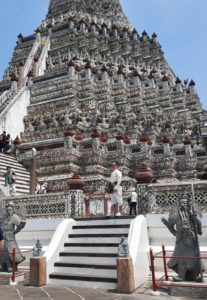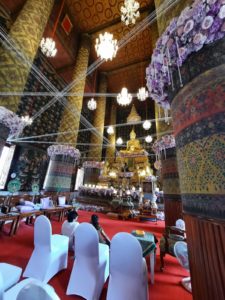 This morning, after tea, I went to Wat Arun. Although I went in the morning I dawdled somewhat so didn’t leave till around 11 and it was very, very hot. Wat Arun shone fiercely white in the sun, its ornament bleached to pastel, and the scores of people who’d rented traditional Thai clothing from the stalls outside looked like faded figures stepped off the side of the stupa.
This morning, after tea, I went to Wat Arun. Although I went in the morning I dawdled somewhat so didn’t leave till around 11 and it was very, very hot. Wat Arun shone fiercely white in the sun, its ornament bleached to pastel, and the scores of people who’d rented traditional Thai clothing from the stalls outside looked like faded figures stepped off the side of the stupa.
It was interesting to see when Angkor Wat was still fresh in my mind. I think it would be better to visit in the evening or morning when the light is slant and the colours alive.
I didn’t stay very long, and considered returning to Ari – I hadn’t had breakfast and it was very hot. Instead I walked towards the Ton Son mosque, Bangkok’s oldest. Along the way I happened to glance down a side street and saw a truly horrific sight: one that I won’t write more about here but that really shook me.
 The mosque was another 5 minutes on, under a flyover and past what looked like an under-flyover classroom. It was locked but looked peaceful and beautiful from outside and calming to the eye and heart after what I’d seen. It was instantly in old Bangkok, as it was in a neighbourhood of narrow streets and canals, shaded with trees – not yet a place where a motorway had been driven through. I walked a little further and came to another wat, this one virtually empty other than two people praying in the main hall. I realised I’d seen them before – not once but a couple of times, what looked like a brother and sister who had been at every altar in Wat Arun. I wondered what they were praying for – a sick parent, perhaps, or maybe that’s projection.
The mosque was another 5 minutes on, under a flyover and past what looked like an under-flyover classroom. It was locked but looked peaceful and beautiful from outside and calming to the eye and heart after what I’d seen. It was instantly in old Bangkok, as it was in a neighbourhood of narrow streets and canals, shaded with trees – not yet a place where a motorway had been driven through. I walked a little further and came to another wat, this one virtually empty other than two people praying in the main hall. I realised I’d seen them before – not once but a couple of times, what looked like a brother and sister who had been at every altar in Wat Arun. I wondered what they were praying for – a sick parent, perhaps, or maybe that’s projection.
The main hall was calm and beautifully painted, so completed the job of soothing. Behind it was another prayer hall, this one with a plaster statue that, in the middle of the last century, was realised to be gold covered in plaster, from Sukhotai. What a thing to discover. Again the brother was there but not the sister this time.
Outside the wat, through a narrow alley, was a rectangular pool of running water, with amulets with different virtues buried at each cardinal point. The statue of King Thaksin, the founder of Thonburi (Bangkok’s predecessor capital and this neighbourhood of the city), dressed in 18th century military uniform, faced the pavilion of the Buddha across the length of the pool. It was fiercely bright and very peaceful.
I took a grab then, to lunch at a Burmese restaurant where it felt like being in South Asia more than SE Asia as the young Burmese waiters had a particular type of respectful courtesy that felt very desi (not that it’s invariable, far from it, but when young Pakistani/Indian/Bangladeshi and clearly Burmese men are playing that role, it has a very distinct feel to it. EM Forster would recognise it, perhaps). Anyway, a pleasant meal though the tea leaf salad wasn’t quite the psychotic attack on the taste bubs that I remember from my one meal in Burma, when the GF and I crossed the border for a day for a visa run. It was also one of the few notable times when border officials looked at the Pakistani passport I carried at the time and broke into welcoming smiles, much to the GF’s amusement. That time I was given the gift of a bead by an elderly Muslim man who remembered and loved Karachi. He must have been Rohingya. I wonder what happened to him in the years that followed, but he might be long dead.
From Burma to Nana, my (and the GF’s) preferred cafe in Ari where I am now recognised as the person who insists on a glass, not a disposable cup, for her iced latte. And finally back to the flat to draw the curtains and turn on the air conditioner for a bit and to hide from the sun.